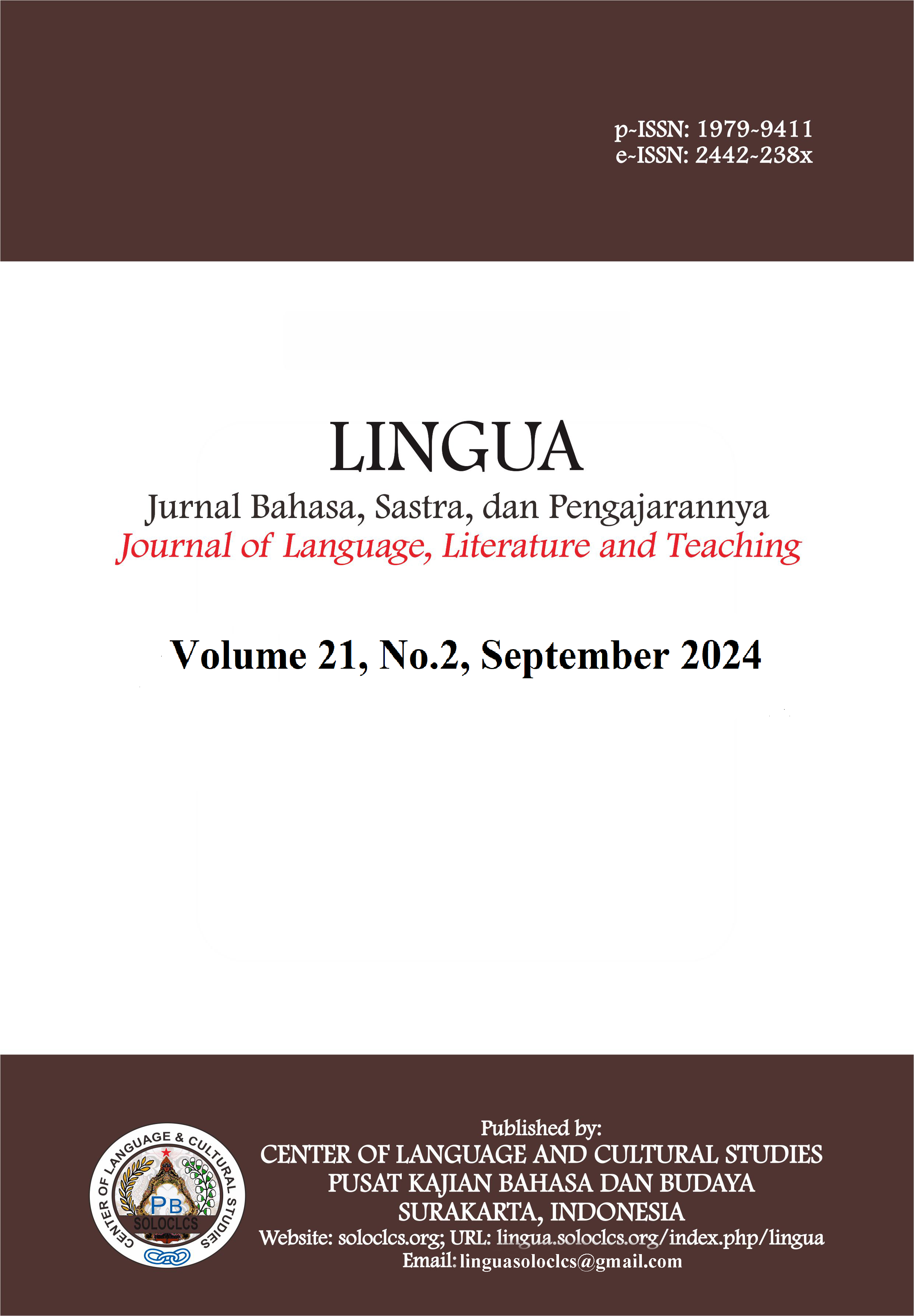Grammar Tips Integrated with Telegram Bot: Strategies to Facilitate Learning English Grammar
DOI:
https://doi.org/10.30957/lingua.v21i2.965Keywords:
English grammar, multimodality, Telegram botAbstract
The development of technology is very useful to support students in learning linguistics. This study aims to explain the design and ground in multimodal communication to facilitate students in learning English grammar. This research is a field research located in the English Literature Study Program, Faculty of Letters, at Universitas Warmadewa, which applies qualitative methods. This study employs the theory of multimodal communication. Databases related to grammar tips and evaluations were added and presented with appropriate design through ELIA. The data were taken from the communication logs, and the learn and practice dashboard. Based on the analysis, the design includes three important parts, namely genre, mode, and discourse. The focus of the design is the mode chosen to deliver information (ground). The mode is presented in the form of text such as grammar materials and MCQs. However, the visual mode is presented in the form of graphs and charts that show the progress of students learning grammar materials.
Downloads
References
Chaves, A. P., & Gerosa, M. A. (2020). How Should My Chatbot Interact? A Survey on Social Characteristics in Human–Chatbot Interaction Design. International Journal of Human–Computer Interaction, 1–30. https://doi.org/https://doi.org/10.1080/10447318.2020.1841438
Crolic, C., Thomaz, F., Hadi, R., & Stephen, A. T. (2022). Blame the Bot: Anthropomorphism and Anger in Customer–Chatbot Interactions. Journal of Marketing, 86(1), 132–148. https://doi.org/10.1177/00222429211045687
Dharwadkar, R., & Deshpande, N. A. (2018). A Medical ChatBot. International Journal of Computer Trends and Technology (IJCTT), 60(1), 41–45.
Francesco Colace, Santo, M. De, Lombardi, M., Pascale, F., & Pietrosanto, A. (2018). Chatbot for E-Learning: A Case of Study. International Journal of Mechanical Engineering and Robotics Research, 7(5), 528–533.
Freidkin, I. L., & Ksenofontova, S. B. (2021). Foreign Language Teaching Methods of Nowadays: Telegram-bot "Pardes". ARPHA Proceedings, 279–298. https://go.gale.com/ps/i.do?p=AONE&sw=w&issn=26830183&v=2.1&it=r&id=GALE%7CA675338581&sid=googleScholar&linkaccess=fulltext
Hiremath, G., Hajare, A., Bhosale, P., Nanaware, R., & Wagh, K. S. (2018). Chatbot for Education System. International Journal of Advance Research, Ideas and Innovations in Technology, 4(3), 37–43.
Kim, S., Eun, J., Oh, C., Suh, B., & Lee, J. (2020). Bot in the Bunch: Facilitating Group Chat Discussion by Improving Efï¬ciency and Participation with a Chatbot. CHI, 1–13. https://doi.org/http://dx.doi.org/10.1145/3313831.3376785
Kress, G. (2010). Multimodality: A social semiotic approach to contemporary communication. Routledge.
Lalwani, T., Bhalotia, S., Pal, A., Bisen, S., & Rathod, V. (2018). Implementation of a Chatbot System using AI and NLP. International Journal of Innovative Research in Computer Science & Technology (IJIRCST), 6(3), 26–30.
Lee, C. (2018). Introduction: Discourse of Social Tagging. Discourse, Context & Media, 22, 1–3. https://doi.org/10.1016/j.dcm.2018.03.001
Lowrey-Kinberg, B. (2019). Experimental results on the effect of politeness strategies on perceptions of police. Language & Communication, 69, 42–53. https://doi.org/10.1016/J.LANGCOM.2019.05.002
Mandalika, D., Ramadhanty, F., Dasuki, & Suseno, M. (2023). Telegram Bot as a Digital Learning Platform in English Language Teaching and Learning. English Language & Literature International Conference, 608–622.
Manullang, E. B., Hartati, R., & Nasution, R. D. (2023). Utilization of Chatbot Telegram AI to Promote Students’ Creative and Innovative Entrepreneurship in Learning Context. SALTeL Journal (Southeast Asia Language Teaching and Learning), 6(2), 27–35. https://doi.org/10.35307/SALTEL.V6I2.111
Michelson, K., & Valencia, J. A. Ã. (2016). Study Abroad: Tourism or education? A multimodal social semiotic analysis of institutional discourses of a promotional website. Discourse & Communication, 10(3), 235–256. https://doi.org/10.1177/1750481315623893
Nagarhalli, T. P., Vaze, V., & Rana, N. K. (2020). A Review of Current Trends in the Development of Chatbot Systems. 2020 6th International Conference on Advanced Computing and Communication Systems (ICACCS), 706–710. https://doi.org/10.1109/ICACCS48705.2020.9074420
Ranoliya, B. R., Raghuwanshi, N., & Singh, S. (2017). Chatbot for University Related FAQs. IEEE, 1525–1530.
Scott, K. (2018). “Hashtags work everywhereâ€: The pragmatic functions of spoken hashtags. Discourse, Context & Media, 22, 57–64. https://doi.org/10.1016/j.dcm.2017.07.002
Skjuve, M., Følstad, A., Fostervold, K. I., & Brandtzaeg, P. B. (2021). My Chatbot Companion - a Study of Human-Chatbot Relationships. International Journal of Human - Computer Studies, 149, 1–14.
Syahreza, & Hartina, S. (2023). TEACHING WRITING THROUGH TELEGRAM BOT : THE IMPACT ON STUDENTS WRITING PERFORMANCE. Jle: Journal of Literate, 4(1), 1–8. https://journal.uiad.ac.id/index.php/jle/article/view/2091/935
Yan, R. (2018). “Chitty-Chitty-Chat Botâ€: Deep Learning for Conversational AI. Twenty-Seventh International Joint Conference on Artiï¬cial Intelligence, 5520–5526.
Zappavigna, M., & Martin, J. R. (2018). #Communing afï¬liation: Social tagging as a resource for aligning around values in social media. Discourse, Context & Media, 22, 4–12. https://doi.org/10.1016/j.dcm.2017.08.001
Downloads
Published
How to Cite
Issue
Section
License
Authors who publish with this journal agree to the following terms:
- Authors retain copyright and grant the journal right of first publication with the work simultaneously licensed under a Creative Commons Attribution-ShareAlike 4.0 International License that allows others to share the work with an acknowledgement of the work's authorship and initial publication in this journal.
- Authors are able to enter into separate, additional contractual arrangements for the non-exclusive distribution of the journal's published version of the work (e.g., post it to an institutional repository or publish it in a book), with an acknowledgement of its initial publication in this journal.
- Authors are permitted and encouraged to post their work online (e.g., in institutional repositories or on their website) prior to and during the submission process, as it can lead to productive exchanges, as well as earlier and greater citation of published work (See The Effect of Open Access).















